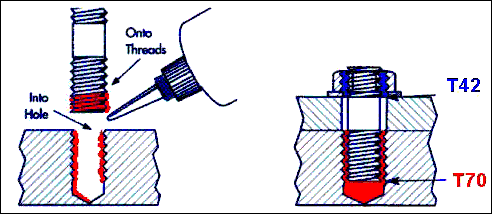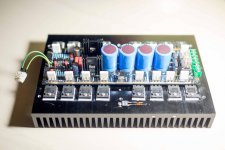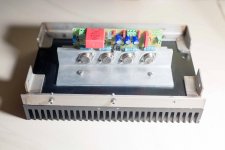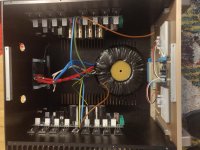Ok, thanks for the info. I just copied the link from the sellers website..
I had no idea there are so many variables to look for. I will look for thicker goods.
The problem is that a 6mm goods thickness means a L 60x60 mm dimension. Which is too big 🙁
My heatsinks are 300X115X40 mm. (I have four)
I could go for a U-profile of 40x60x40x5mm or 40x80x40x5mm. I hope either one of those can transfer enough heat!
I had no idea there are so many variables to look for. I will look for thicker goods.
The problem is that a 6mm goods thickness means a L 60x60 mm dimension. Which is too big 🙁
My heatsinks are 300X115X40 mm. (I have four)
I could go for a U-profile of 40x60x40x5mm or 40x80x40x5mm. I hope either one of those can transfer enough heat!
Last edited:
Just to illustrate what I have done. I have made several re-builds of my initial NHB-108 and every time there were a dozen of new threads. Meanwhile I had a board on aluminium plate fixed on the heat sink. Then I said: "Enough now, you never surrender and what is this? You do it properly or abandon!"
I have used some pieces of aluminium to develop skills. Then, I got back to the bemch and fixed the transistors directly on board, with alumina pads and sufficient amount of thermal paste. Now, the temperature is under control.
Below are two other boards,
Accuphase A60+ clone and
JLH 2005.
I have enjoyed the work with these projects.
I have used some pieces of aluminium to develop skills. Then, I got back to the bemch and fixed the transistors directly on board, with alumina pads and sufficient amount of thermal paste. Now, the temperature is under control.
Below are two other boards,
Accuphase A60+ clone and
JLH 2005.
I have enjoyed the work with these projects.
Attachments
Last edited:
Thanks Andrew! I do indeed appreciate your opinion.🙂You are Master Builder Berlusconi.
Just to illustrate what I have done. I have made several re-builds of my initial NHB-108 and every time there were a dozen of new threads. Meanwhile I had a board on aluminium plate fixed on the heat sink. Then I said: "Enough now, you never surrender and what is this? You do it properly or abandon!"
I have used some pieces of aluminium to develop skills. Then, I got back to the bemch and fixed the transistors directly on board, with alumina pads and sufficient amount of thermal paste. Now, the temperature is under control.
Below are two other boards,
Accuphase A60+ clone and
JLH 2005.
I have enjoyed the work with these projects.
Beautiful assembly. But you better avoid screws and use studs with threadlocker, insulator (when needed), washer, lock washer, nut (never self-locking nuts). In this way the threaded hole on the aluminum will not strip.
2. and even more importantly: LUBRICATE while making threads, profusely. I use WD40 or MIG welding liquid.
Alcohol works very well (I would say better than WD40) for aluminium. Not the alcohol you drink, it should be pure alcohol.
Thanks Marigno,Beautiful assembly. But you better avoid screws and use studs with threadlocker, insulator (when needed), washer, lock washer, nut (never self-locking nuts). In this way the threaded hole on the aluminum will not strip.
A wonderful idea, again from you. Perfect. This method provides safety for otherwise vulnerable aluminium threads.

Details of the proposed method in the link linked PDF file.
You're doing very well Erlend 🙂
Thanks Rallyfinnen,Alcohol works very well (I would say better than WD40) for aluminium. Not the alcohol you drink, it should be pure alcohol.
It would be indeed reckless to waste fine Vodka on lubrication of threads.


My dear Paroxod, Instead of direct answer, let me tell you a story:Berlusconi, ...which of the amplifiers won.😀
Father-bull and son-bull are lying in a shade on top of the hill and are observing a herd of cows down there in a valley. They talk:
Son-bull: "Daddy, which one you prefer?"
Father-bull: "Shut-up son and let's go down to the valley and take them all" 😀
An externally hosted image should be here but it was not working when we last tested it.
Last edited:
Just to illustrate what I have done. I have made several re-builds of my initial NHB-108 and every time there were a dozen of new threads. Meanwhile I had a board on aluminium plate fixed on the heat sink. Then I said: "Enough now, you never surrender and what is this? You do it properly or abandon!"
I have used some pieces of aluminium to develop skills. Then, I got back to the bemch and fixed the transistors directly on board, with alumina pads and sufficient amount of thermal paste. Now, the temperature is under control.
Below are two other boards,
Accuphase A60+ clone and
JLH 2005.
I have enjoyed the work with these projects.
Nice work Berlusconi!
My dear Paroxod, Instead of direct answer, let me tell you a story:
Father-bull and son-bull are lying in a shade on top of the hill and are observing a herd of cows down there in a valley. They talk:
Son-bull: "Daddy, which one you prefer?"
Father-bull: "Shut-up son and let's go down to the valley and take them all" 😀
😀😀😀
WOW ! what rails can be used with this if you want to bias AB?
Thanks Primare! I'm glad to hear from you. It would be fine to have you here steady because this amplifier is worth it despite some (unfounded) criticism. It sounds fine, it is fun to build it and we have here really nice group of people building it.Nice work Berlusconi!
There is a permanent question hanging above us: is it 100% copy? It really doesn't matter at all but it is very likely that some Chinese guy got an original and disassembled and copied it. There is a thread on some Chinese forum that corroborates that. But does it really matter if it sounds good and has measurements identical to these published? Therefore I call this project just NHB-108 without naming it D..TZ...el. It simply sounds incredibly good.
There were also some unfounded rumours that servo deteriorates sound but Marigno has found out that it works well if built from good components. And that is what I am going to deal with during January and probably March. I am expecting the boards to arrive soon and I will stuff them with components that have already arrived from trustworthy source. In short, there is in front of us a lot of things to do.
Cheers

It should be a good project. Good, elegant and sophisticated solution for the input stage and VAS, both cascodes. But, even if it is a CFA, it still uses feedback from the output, so it is out from my scope.
Before moving to the US, I was used to go to all HiFi gala in Rome, I have listened several of times the Aleph, the medium and the biggest ones. They are class A single-ended VFAs. I was never impressed; the "Superfinale" by Aloia was far better, it has an AB class final stage and has a low factor CFb loop from the output and a VFb loop inside the VAS.
I'm not so sure if the 108 is a VFA or CFA, seems to be the first one, since it uses a capacitor in the Fb loop, directly connected from the end to the beginning of the loop. But, after becoming a WHA217, you can be sure that the load perturbation will not arrive to the internal feedback loop in significant amount. And the diodes on the Diamond never switch. I have to remove them.
krellname I am afraid the proposed solution for offset trimming will introduce some DC to the source.
Did you remove D1 and D2 (MUR120RLG)?
I didn't but I will.
I have to think about doing it a little more.
As per my spreadsheet, those diodes will never switch in the WHA-217.
Putting apart the thing is not so simple and a diode that does not switch is like it didn't exist.
Attachments
- Home
- Amplifiers
- Solid State
- Dartzeel amp schematic - build this?



